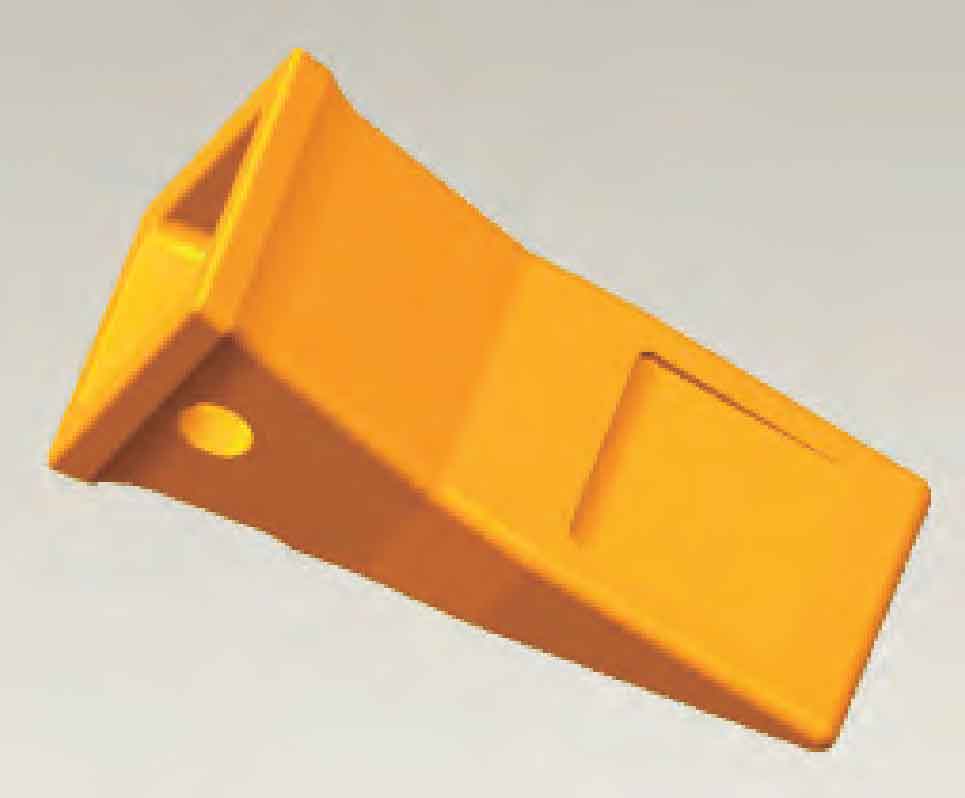Bucket teeth are critical wear components in excavators that directly contact soil and rock. During operation, bucket teeth experience intense impact, bending, and sliding forces, leading to rapid wear and deformation. As such, bucket tooth materials require exceptional strength, toughness, and wear resistance simultaneously. Forged components generally exhibit superior mechanical properties compared to cast parts but require subsequent quenching heat treatment. Current industrial practices include conventional post-forging quenching or forging-remnant-heat quenching. This study proposes an innovative semi-forging-remnant-heat quenching (SFRQ) technology specifically optimized for mining excavator bucket teeth manufactured from 40Cr steel. The core innovation lies in controlling the pearlite transformation kinetics to eliminate deleterious banded structures while significantly reducing energy consumption.

The commercial 40Cr steel used in this study has the chemical composition shown in Table 1. The SFRQ process sequence is illustrated in Figure 1. After forging at 1,200°C with a final forging temperature of 860°C, the bucket tooth component is rapidly cooled to a critical temperature below the pearlite transformation zone. This temperature is maintained for sufficient duration to achieve complete isothermal pearlite transformation before reheating to the austenitizing region for final quenching and tempering.
| C | Si | Mn | Cr | S | P | Fe |
|---|---|---|---|---|---|---|
| 0.40 | 0.28 | 0.65 | 0.98 | <0.04 | <0.04 | Bal. |
The critical pearlite transformation temperature was determined through systematic experimentation. Specimens were austenitized at 860°C for 60 minutes, rapidly cooled to temperatures ranging from 780°C to 610°C, held for 30 minutes, then water-quenched. Hardness measurements revealed a dramatic transition between 650°C and 680°C:
$$ \Delta H_{650^\circ C \rightarrow 680^\circ C} \approx 40 \, \text{HRC} $$
Microstructural analysis confirmed this transition. At 680°C (Figure 2a), the microstructure consisted of proeutectoid ferrite (gray matrix) and martensite (white regions), with martensite laths visible under higher magnification. At 650°C (Figure 2b), the structure transformed to proeutectoid ferrite and pearlite, with distinct lamellar cementite/ferrite layers characteristic of complete pearlite transformation. This confirms 650°C as the critical temperature for complete pearlite transformation in 40Cr bucket tooth steel.
| Quenching Process | Hardness (HRC) | Impact Energy (J/cm²) |
|---|---|---|
| Semi-Forging-Remnant-Heat | 45 | 35 |
| Forging-Remnant-Heat | 44 | 5 |
| Conventional Quenching | 45 | 34 |
The optimized SFRQ thermal profile for bucket tooth production is: Forging (1,200°C → 860°C) → rapid cooling to 650°C → 30 min isothermal holding → reheating to 860°C → 90 min austenitization → quenching → 380°C tempering (180 min). The isothermal holding at 650°C enables full pearlite transformation, eliminating detrimental forging deformation structures. Mechanical testing demonstrates that SFRQ-processed bucket teeth achieve impact toughness 7× higher than forging-remnant-heat quenched components (35 J/cm² vs. 5 J/cm²), while matching conventional quenching hardness (45 HRC).
Thermodynamic analysis explains these results. The SFRQ process modifies the phase transformation pathway through:
$$ \gamma_{\text{forged}} \xrightarrow{\text{Cooling}} \alpha + \gamma_{\text{residual}} \xrightarrow{650^\circ \text{C}} \alpha + P \xrightarrow{\text{Reheat}} \gamma_{\text{new}} \xrightarrow{\text{Quench}} \alpha’ + \text{tempered martensite} $$
where complete pearlite (P) formation at 650°C eliminates banded structures inherited from forging deformation. In contrast, forging-remnant-heat quenching directly transforms residual austenite to martensite, preserving deformation-induced banding that severely compromises bucket tooth impact resistance. The SFRQ process reduces energy consumption by 25-30% compared to conventional quenching by eliminating the room-temperature cooling and reheating cycle, while the 30 min isothermal treatment adds minimal processing time.
Microstructural refinement mechanisms further explain the performance advantages. The complete dissolution of deformation bands during pearlite transformation and subsequent re-austenitization produces a homogeneous microstructure. The prior austenite grain size (PAGS) refinement follows the relationship:
$$ \text{PAGS}_{\text{SFRQ}} = k \cdot \left( \dot{\epsilon}^{-0.5} \right) \cdot \exp\left(-\frac{Q}{RT_{\text{reheat}}}\right) $$
where controlled reheating prevents grain growth. This refined microstructure enhances crack propagation resistance critical for bucket tooth durability under impact loading. Field tests demonstrate 40-50% longer service life for SFRQ-processed bucket teeth compared to conventional counterparts in mining excavation applications.
In conclusion, the semi-forging-remnant-heat quenching process establishes 650°C as the critical pearlite transformation temperature for 40Cr bucket tooth steel. This temperature enables complete phase transformation that eliminates forging-induced banded structures while providing superior impact toughness compared to direct forging-remnant-heat quenching. The process reduces energy consumption by 25-30% and processing time by 15-20% compared to conventional quenching, offering a cost-effective solution for high-performance bucket tooth manufacturing. The optimized thermal profile balances microstructural control and production efficiency, making it particularly suitable for mass production of mining excavation components where impact resistance determines service life.
